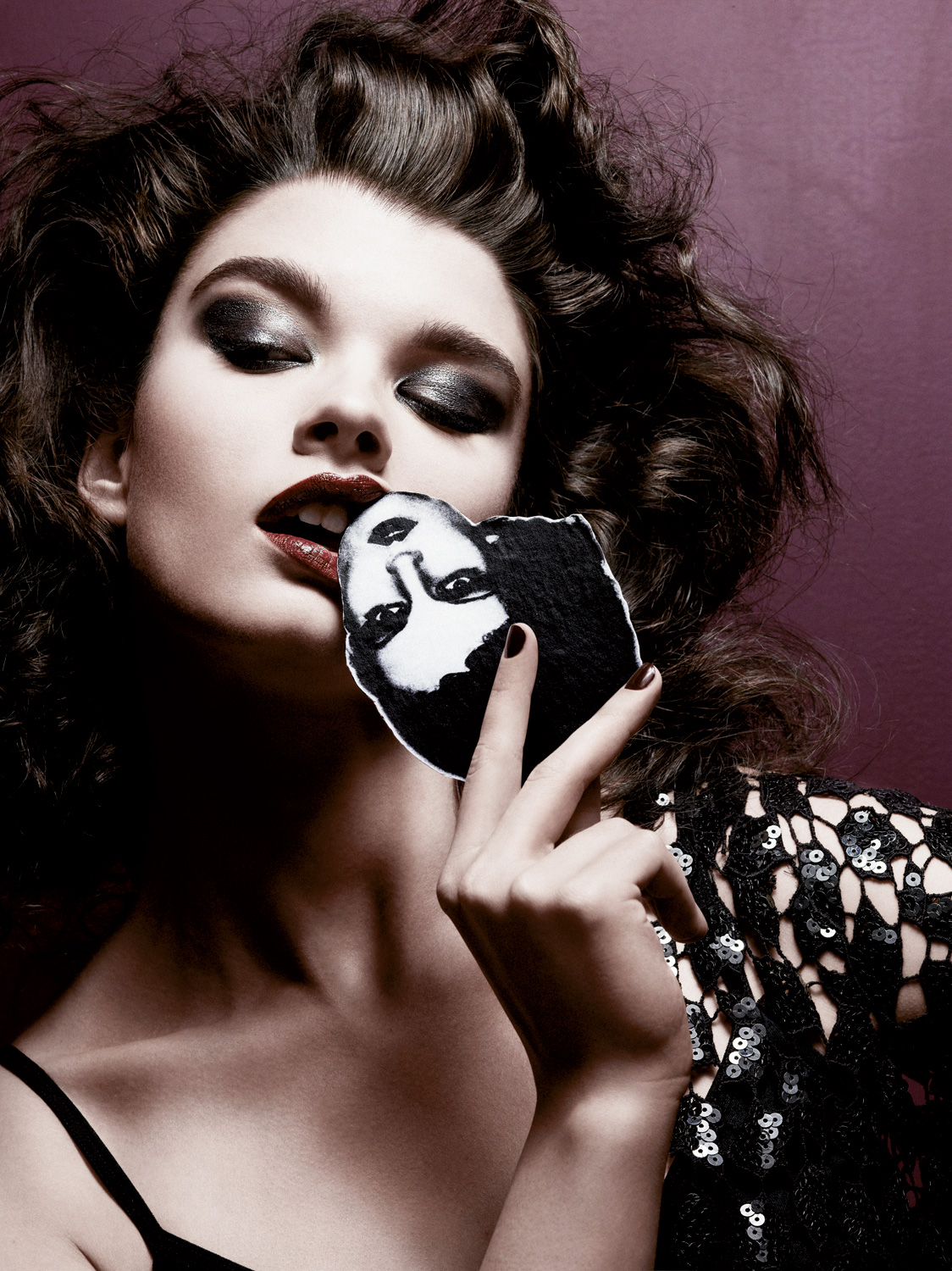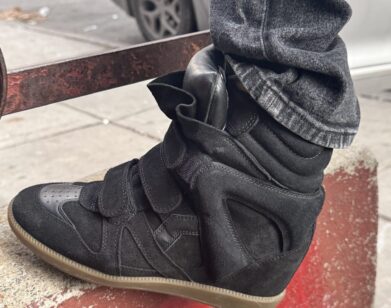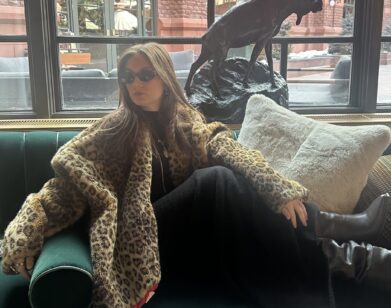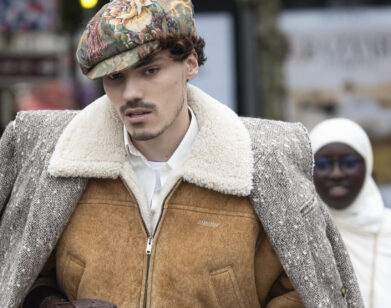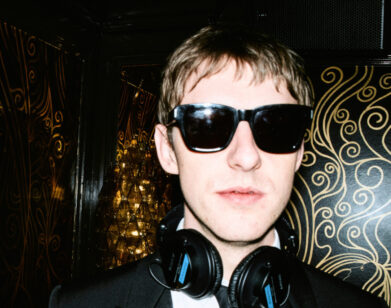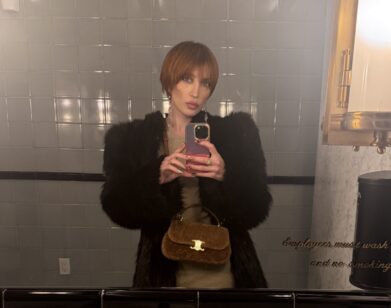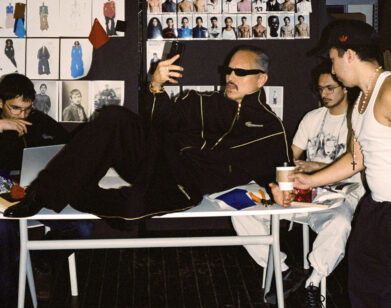Heidi Morawetz
For 30 years, makeup artist Heidi Morawetz worked in the studio at Chanel alongside Dominique Moncourtois—Morawetz as director of the makeup creation studio, Moncourtois as international director of makeup creation. There, with Karl Lagerfeld, they pioneered the idea that cosmetics could be just as fashionable as clothes. In the process, they masterminded some of Chanel’s most memorable products, among them Rouge Noir, released in the U.S. as Vamp, which was invented on the fly backstage before the 1994 autumn ready-towear collection, a story that has become the stuff of lore. The potent mix of deep red and black nail polish delighted the fashion press and the public. Uma Thurman memorably wore the polish for her role in Pulp Fiction (1994), launching the trend that became a phenomenon.
Before joining Chanel, Morawetz worked in the early ’70s for photographer Guy Bourdin—notably on his surreal campaigns for Charles Jourdan. Yves St. Laurent became a fan of her work through her association with Bourdin and invited her to create YSL’s first makeup line, which launched in 1978. Her list of other collaborators is an impressive one: Sarah Moon, David Bailey, Helmut Newton, Richard Avedon, François Lamy, Irving Penn, Bruce Weber. Not that she’ll brag about it. Morawetz never studied fashion formally and claims to have forgotten more jobs than she remembers. But the 71-year-old Morawetz has influenced makeup artists everywhere with her interest in technological innovation, her experimentation with pigments, and, above all, her open-minded approach to the possibilities of her chosen medium—an approach that has helped shape the face of fashion over the last four decades. Peter Philips, who took over for Morawetz and Moncourtois at Chanel in 2008, met with Morawetz in Paris.
PETER PHILIPS: You went to art school. Were you already interested in fashion at that point?
HEIDI MORAWETZ: I did art school, but I never learned anything about makeup. [laughs] It’s true. I was on vacation in Paris and I met Guy Bourdin, because he was my best girlfriend’s husband. He pulled makeup out of his wallet and he said to me, “Well, if you can paint on paper, you must be able to paint on a face. This is the makeup box, and this is how you have to start.”
PHILIPS: That’s a great start. For that first shoot, what makeup did you do?
MORAWETZ: This was the moment when you had to put on lots of long fuzz lashes. It was the ’70s. The thing that I was not used to was that I had to paint everything— the body and face—because there was absolutely no retouching.
PHILIPS: That’s also how I discovered there’s no safety net. Especially when you’re shooting black-and-white. Then you have to kind of correct the coloring, working with blue and yellow and the shades, too, to make sure that parts that were in the shadow look differently than the parts that catch the light. Was Karl [Lagerfeld] working for [Charles] Jourdan in those days?
MORAWETZ: Karl was very good friends with Guy, and he was just incredibly generous. He made special clothes for Guy . . . I remember he made a very beautiful dress, but the model just ended up being naked in the tub.
PHILIPS: How did you start working for Yves St. Laurent?
MORAWETZ: When they created their first makeup line, St. Laurent wanted to have somebody for the makeup, and he asked to get me because my name was in Vogue with Guy Bourdin, and he liked Guy’s work.
PHILIPS: So did you start the first makeup line at St. Laurent, or was somebody else doing it before you?
MORAWETZ: No. It was the first makeup line
PHILIPS: Did you also do the YSL shows? MORAWETZ: Yes. PHILIPS: Was it like it is now?
MORAWETZ: No. The makeup artists were not as organized as now. Now, you have a big team.
PHILIPS: Yes, it’s almost like a factory now. Did you ever need a team of assistants?
MORAWETZ: Not assistants. You asked some other makeup artist friends if they’d come and help you. This is how it was!
PHILIPS: How did you start developing the YSL cosmetic line? MORAWETZ: In those days, we gave them the colors, and they did it in the lab, and then we decided what we wanted to do, which colors we would take.
PHILIPS: Who shot those ads?
MORAWETZ: François Lamy. They were always overexposed photographs, so you had to put a lot of makeup on, otherwise you wouldn’t see anything.
PHILIPS: So how did you end up at Chanel?
MORAWETZ: It’s a funny story. One day I was at St. Laurent, and someone whose secretary was out forgot to tell me there was a shoot somewhere! So I had an argument with her on the telephone, and in those days, there weren’t so many makeup artists like now, and the few there were, you knew them all. So Dominique was in the studio doing a makeup film, and he heard me screaming with this girl on the phone, and two days later he called me and he said, “Just come and work for Chanel.” Karl came pretty quickly after that.
PHILIPS: You also worked with Sarah Moon, who has a very specific style, and, in particular, a very specific makeup style in her pictures.
MORAWETZ: She always said, “I like black eyes— like holes.” So we had all these very dark eyes with very white faces, and the lips were very designed, very drawn. She is an absolutely adorable person, but she knows exactly what she wants.
PHILIPS: What was the story about when you were shooting with Guy Bourdin and you had to do something with pigments in the water?
MORAWETZ: Oh, he wanted me to make the water very, very blue, because in the Atlantic Ocean, the water is not very blue! So I asked a friend of mine, who is a chemist, what I could I do to make the Atlantic Ocean look really blue. He got me some chemical thing . . . It was was blue, but it didn’t last long enough to get the picture.
PHILIPS: Over 30 years, you can actually see the evolution of the quality of products, pigments, and new formulas. When was the first time you thought, Oh my god, now we’ve got something really amazing— like a new foundation or lipstick formula— when you thought you had something that was totally different from what’s been done before?
MORAWETZ: The first important thing in makeup was from Japan, where they discovered the lightreflecting pigments. It really made the skin look better. This was a revolution. It allowed you to make a foundation and still make an optical effect so that the wrinkles would look less deep. Now everybody uses it.
PHILIPS: Remember when we thought of the name for Particulière?
MORAWETZ: Oui, oui, yes . . . And when we did all the colors, the names for Rouge Coco? We were there until 11 o’clock in the evening. Do you remember?
PHILIPS: I remember. I love doing the names. Sometimes it’s tongue-in-cheek. What’s the story behind Rouge Noir?
MORAWETZ: I had seen a photograph in black-andwhite, and in black-and-white, eyes and nails turns black. I thought maybe we should do something for the nails like that, and we did this black Rouge Noir in our kitchen, Dominique and myself. Don’t ask me how the quality was.
PHILIPS: You were mixing pigments?
MORAWETZ: Yes, we did our pigments ourselves, and very often we did the mixing ourselves. The manicurist said, “What is this terrible quality that you’re giving me here?” But we had to do it fast, in two days before the show. And then in the lab, they made it nice, of course. But the journalists saw it in the show, and they thought it was incredible, “What’s this color?” The Americans did it right away because they could just put it on the counter. So it came out in America before it did here in Paris.
PHILIPS: Under the name Vamp.
MORAWETZ: Yeah, it was already registered as “Rouge Noir,” but since they did it before us, at the last moment, they called it Vamp. We never thought it would be such a success.
PHILIPS: An amazing success. It still is today.
MORAWETZ: I know. But also Le Blanc de Chanel was more like the white base. Of course, every makeup artist has some white in his box, in case you want to correct something. We thought maybe we could do this transparent white face. We thought it would be just a little accessory, but it turned into a big thing.
PHILIPS: And did that also start, for example, the whitening line in Japan?
MORAWETZ: No, it’s not the same thing, because the whitening line has Vitamin C in it. It’s a treatment. This was in makeup. I was very interested in all the new pigments and new chemical things that you could do, and especially within the industry of makeup. Today, everything is much more regulated, so that there are no problems with allergies. But that’s good because it’s for the woman’s security. Even some color pigments, you can’t use them anymore. I mean, how many times we had to reformulate lipsticks, and even nail polish, because some pigments were forbidden . . . And then you have a problem, you know, how to get the right color when the pigment doesn’t exist anymore.
PHILIPS: And what’s your favorite product? The thing you like for yourself or recommend to everyone?
MORAWETZ: Mascara, black crayon. Transparent powder. I am addicted to the Chanel powder, to mascara, and to black crayon . . .
PHILIPS: And Body Cream No. 5.
MORAWETZ: Yes, No. 5 Body Cream. You know everything about me. But there are also products that I love for other people.
PHILIPS: And what are they?
MORAWETZ: For nails, if you have very nice hands, you can use black or rouge . . . Rouge Noir or Particulière. It’s like an accessory. Instead of a ring, you have a nice nail polish. And if you don’t have wonderful hands, it’s nice to have your nails natural, because it makes your hands look clean and nice.
PHILIPS: Looking back, when you see all these amazing pictures you’ve helped make, how do you feel?
MORAWETZ: I am not somebody who is nostalgic. Not at all. I look at all these pictures, and I think they’re beautiful, I think that Bourdin is very modern, probably the most modern of all. It’s fun, it’s color, it’s young, and I love the photographs. I’m very happy that they did this, but I don’t take myself seriously at all. You know me.
PHILIPS: I know.
MORAWETZ: I think you can do wonderful jobs, wonderful work, and amuse yourself. But I don’t like people who get their head so big that they can’t walk through the door anymore.
Peter Philips is Creative Director of Chanel Makeup.

